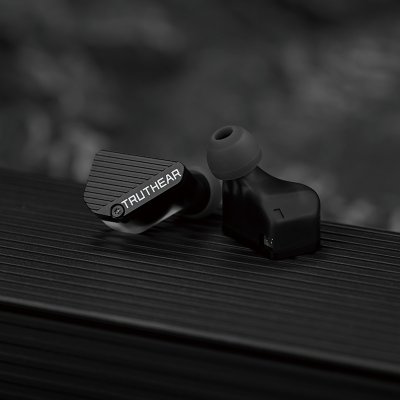Tanchjim Origin and Truthear Pure use 1DD and 1DD+3BA driver setups respectively. Tanchjim Origin costs $280 while Truthear Pure costs $90. Tanchjim Origin is $190 more expensive. Tanchjim Origin holds a decisive 1.1-point edge in reviewer scores (7.2 vs 6.2). User ratings place Tanchjim Origin at 7.6 and Truthear Pure at 8.5. Tanchjim Origin has better bass with a 0.5-point edge, Tanchjim Origin has significantly better mids with a 1.1-point edge, Tanchjim Origin has better treble with a 0.6-point edge, Tanchjim Origin has better dynamics with a 0.9-point edge, Tanchjim Origin has slightly better soundstage with a 0.3-point edge, Tanchjim Origin has better details with a 0.9-point edge and Tanchjim Origin has significantly better imaging with a 1.2-point edge.
Insights
| Metric | Tanchjim Origin | Truthear Pure |
|---|---|---|
| Bass | 7.4 | 6.9 |
| Mids | 7.3 | 6.2 |
| Treble | 7.4 | 6.9 |
| Details | 7.5 | 6.6 |
| Soundstage | 6.8 | 6.6 |
| Imaging | 7.7 | 6.5 |
| Dynamics | 7.4 | 6.4 |
| Tonality | 7.4 | 6.4 |
| Technicalities | 7.4 | 6.3 |
Tanchjim Origin Aggregated Review Score
Average Reviewer Scores
Average Reviewer Score:
7.2Generally Favorable
Truthear Pure Aggregated Review Score
Average Reviewer Scores
Average Reviewer Score:
6.2Mixed to Positive
Reviews Comparison
Tanchjim Origin reviewed by Jaytiss
Youtube Video Summary
Tanchjim Origin gets the “Legendary” treatment for good reason: it’s a clarity-first single-DD that puts finesse over flash. The full-metal shells feel premium but can be slippery and a bit tricky to seat; expect some tip-rolling. Build notes include a semi-recessed 2-pin, a well-cut nozzle, and finish wear that can show with time—ergonomics are fine, just not as contoured as newer designs.
Tuning skews neutral and mid-focused: bass is clean with a light, non-exaggerated thump and controlled mid-bass, so no boom. The midrange is the star, while the treble brings smooth extension and a surprisingly refined sparkle. Technicals impress—pristine resolution, tidy separation, and standout imaging—but there’s no “thunder” down low; some listeners may notice a touch of brightness in the mid-treble. Swappable filters exist, yet their effect is subtle.
Reception has been bullish: Zeos called it obsessively neutral and nearly perfect; Timmy praised it as one of the year’s best with lovely, smooth treble; Super* Review rates it among the better sets under ~$260 while preferring the Chopin. In today’s field—with value picks like Tanchjim Bunny (to sample the signature cheaply) and modern darlings like Softears Volume S—Origin still stands as a refined, resolving choice under $300. Verdict: an A+ recommendation for listeners chasing cleanliness, mids, and imaging; bassheads should look elsewhere.
Jaytiss Youtube Channel
Buy Tanchjim Origin on Linsoul
Ad
Price: $259.99
Buy Tanchjim Origin on Linsoul
Truthear Pure reviewed by Jaytiss
Youtube Video Summary
The Truthear Pure offers a neutral, JM1-style target tuning aimed at a studio-reference sound, achieving this goal competently for its price point. However, its build quality and accessories feel disappointing and recycled from older models like the Hexa. The shell contouring is rigid and unimpressive, while the tips and case lack innovation. The cable is a slight improvement over the Hexa's – supple but lacking clear right/left indicators – making the overall package just okay, not exciting.
Sonically, the Pure presents a linear bass rise and a generally neutral presentation, differing from the Hexa by offering a bit more warmth but less sparkle and magical mid-range presence. While it fixes the Hexa's "pillowy bass," it doesn't fully surpass it, lacking the Hexa's legendary status. Comparisons reveal it's very similar to the Audio Sense DT200 in tonality, though slightly preferred. It falls short against competitors like the Kiwi Ears Quartet (better bass/mids), Ziigaat Lush (better technicalities), Softears Volume S (more natural curve), or planar options around its price. Crucially, the fit is problematic, often requiring expensive aftermarket tips like the Baroque to work well, which feels impractical for a $90 IEM.
Ultimately, the Pure is a solid but middling release, earning a B rating. It suits those specifically seeking an affordable JM1-style neutral signature or dedicated Truthear fans. For most listeners, however, better alternatives exist: the Hexa remains preferable within Truthear's lineup for its magic, the Nova offers more fun, or competitors like the Aful Explorer (bass-focused), TANGZU Fudu (value planar), or slightly pricier Volume S provide more engaging or technically proficient experiences. It's not a strong general recommendation.
Jaytiss Youtube Channel
Buy Truthear Pure on Aliexpress
Ad
Price: $89
Buy Truthear Pure on Aliexpress
Tanchjim Origin reviewed by Tim Tuned
Tim Tuned Youtube Channel
Truthear Pure reviewed by Tim Tuned
Youtube Video Summary
Truthear Pure follows the beloved Hexa with a smarter twist on neutrality: a hybrid 1DD+3BA at $90 that keeps the sturdy 3D-printed shell, slightly chunkier but similarly comfortable. The package is generous—three pairs of “thick” tips, three “thin,” plus foams—along with a much softer, less tangle-prone cable (still a fixed termination) and a soft leather pouch that’s actually pocket-friendly. Build, fit, and accessories punch above price, making this feel more premium than the tag suggests.
Sonically, Pure takes Hexa’s neutral core and downtilts it: a touch more lower-mid energy for weight and body, with the Hexa’s brighter colorations eased back. The result is a warm-neutral, enveloping, and non-fatiguing presentation—vocals and instruments gain richness without mud, and timbre/decay stay natural rather than dark or blunted. Think of the duo like HD600 vs HD650 for IEMs: pick Hexa for cleaner/brighter clarity, pick Pure for fuller, relaxed musicality. Choose Pure if a superbly executed warm-neutral tuning, long-session comfort, and broad genre versatility are priorities (great as a first “do-it-all” IEM). Skip it if a crisper, more analytical, or treble-forward edge is needed—the Pure presents detail naturally rather than pushing it. Either way, Pure carves meaningful space beside Hexa: neither redundant nor straying too far from true neutral, just the right amount of warmth done right. (Also, a white Pure would be fun—name kinda begs for it.)
Tim Tuned Youtube Channel
Tanchjim Origin reviewed by Z-Reviews
Youtube Video Summary
Tanchjim Origin shows up with grown-up design, a slick logo, and a surprisingly nice stock cable—though it’s only 3.5 mm. Under the hood: a single dynamic driver and interchangeable nozzles. The “Dynamic” nozzle thickens the bass into a chewy, fun thump; the “Light” nozzle unlocks the magic—shockingly clean, near-neutral tuning with a tight low end. Tip rolling pays off (foam-filled silicone adds a touch of seal and snap), and the shells feel like proper adult jewelry. The carry case is comically huge, and the 2-pin posts are long, but build is otherwise dialed.
Sonically, Origin hits that “how is this this clean?” tier: vocals are dead-on, the treble stays smooth without bite, and the low end sits ~a hair north of flat for just the right weight. Staging isn’t stadium-wide—image arcs just behind the eyes—but layering, punch, and overall polish scream high-end without needing a mega amp. Swap to the Light nozzle, get a good seal, and it’s a full send: one of the best-sounding single-DD sets in this bracket, the kind that could still be recommended even at a higher tag. Call it a 9/10—dock a point for the non-modular cable and oversized case—but the tuning and refinement are spectacular for the price.
Z-Reviews Youtube Channel
Truthear Pure reviewed by Z-Reviews
Youtube Video Summary
Truthear Pure brings a warm, bass-impactful presentation from its 1DD+3BA setup, but the rest feels like it’s under a blanket. There’s a noticeable 2 kHz hump, then the upper range ducks hard past ~8 kHz, leaving the sound veiled—like three comforters thrown over the music. Great for bass-centric tracks (think Arcane S2 remixes), yet dull and somehow fatiguing at the same time. The shells look cool—semi-transparent with a heatsink-style back—and the stock cable is soft and supple but fixed 3.5 mm. Accessories are classic Truthear: small leather pouch, tip array, and a waifu postcard. Listed around $89 (feels more like $50 value).
The real curveball is the imaging and stage. On 3D test tracks that should sweep smoothly around the head, motion skews and snaps—front/back depth behaves weird and timing feels off. It’s the kind of tuning (or implementation) that begs for EQ just to “open it up”. For listeners who want warmth + bass and the bunny-girl aesthetic, this will scratch the itch. For a cleaner, properly integrated 1DD+3BA experience, alternatives like Defiant make more sense, especially at a similar price. Net: an acceptable set for bass enjoyment, but with odd staging and a rolled-off, veiled top end that keeps it off the must-buy list.
Z-Reviews Youtube Channel
Tanchjim Origin reviewed by Audionotions
Truthear Pure reviewed by Audionotions
Tanchjim Origin reviewed by Gizaudio Axel
Gizaudio Axel original ranking
Gizaudio Axel Youtube ChannelTruthear Pure reviewed by Gizaudio Axel
Youtube Video Summary
Truthear Pure arrives as a $90 1DD+3BA hybrid with a solid accessory set: postcard, soft pouch, six pairs of silicone tips plus foam. The non-modular cable is notably soft, tangle-free, low in microphonics, and the chin slider actually stays put. Shells are semi-transparent 3D-printed resin with a grooved faceplate, a vent, and a nozzle lip that keeps tips secure; there’s a recessed 2-pin connector. Size is only slightly larger than Hexa, but comfort is similarly excellent—low-profile, secure, and easy for long sessions.
Sonically, Pure shifts firmly into warm territory. Bass is abundant with strong slam, yet its slower decay and “glide” into the lower mids introduce a thick, relaxed presentation that can cloud mid-range clarity and leave vocals a touch hazy; the upper-mids sit a bit too laid-back for the bass level. Treble is safe, smooth, and non-fatiguing rather than airy. Technicals are middling for the class—imaging decent, detail behind more incisive sets. Versus Hexa, Pure adds bass and impact but loses the Hexa’s clean, neutral midrange; compared with Moondrop Aria 2, it’s the “too warm” side of warm-tuned. Best suited for listeners who want a cozy, laid-back signature; not ideal for clarity seekers unless EQ is used to trim the low-mids/bass. Final verdict: 3/5 stars—comfortable build and enjoyable smoothness, but the warmth dominates the balance.
Gizaudio Axel original ranking
Gizaudio Axel Youtube ChannelTanchjim Origin reviewed by Jays Audio
Youtube Video Summary
Tanchjim Origin targets a balanced and clean tuning with a sprinkle of mid-bass. Dynamics come across smooth like the EA500LM but a touch cleaner; low-end is punchy, textured, and well separated, just not as tactile in attack as EA1000. The spotlight is vocals: female voices sound sweet, open, and extended without thinness or shout, though there’s less chest depth and a desire for a bit more sparkle. Stage feels tidy rather than expansive—EA1000 projects a more open headspace—so the Origin reads as “very correct,” not showy.
Treble is smooth, clean, and well-extended with no harshness; not Helios-level airy, but enough. Resolution sits close to EA500LM, while EA1000 delivers sharper transients and a slightly more resolving edge. Character map: Origin = balanced/clean, EA1000 = slightly bright/sparkly, EA500LM = warmest/bassiest. All three are mid-volume listens stock. With mods, EA1000 proves the most flexible and gains that engaging “special sauce” with more tactile bass and vocal energy; Origin is easier to dull or darken; LM can tip into too much bass with added damping.
In today’s market the Origin sits in a tough spot: EA1000 beats it on price, engagement, and mod scaling, while EA500LM undercuts it with better bass texture and value. With contenders like Nova, Chopin, Quintet, and Hype 2 swirling around, Origin makes the most sense if a balanced, smooth single-DD is wanted without a mid-bass scoop. The extra nozzles don’t meaningfully change things, and a price near $150 would feel far more justified. Otherwise, waiting for the next wave may be the smarter play.
Jays Audio Youtube Channel
Truthear Pure reviewed by Jays Audio
Youtube Video Summary
Truthear Pure lands as the so-called Hexa successor, but the tuning pivots hard: it’s warmer, darker, and even more laid-back. Male vocals pop with weight, extension, and a lush low-end foundation. At mid-to-low volumes it can come off bloated and a little low-res up top, with dulled upper-mid/treble detail; push it to around 75 dB+ and it scales nicely, opening the stage, adding clarity, and staying non-fatiguing thanks to the tamer upper mids.
Genre pairing leans into hip-hop, rap, R&B, jazz, and rock/metal: there’s satisfying mid-bass impact and sub-bass rumble, with restrained upper mids keeping sibilance and shout in check on hotter recordings. Tipwise, avoid bass-boosters like Final E, Divinus Venus, and even the stock silicones. Go with Softears Ultra Clear or other clear, open-bore tips to nudge in more treble air while keeping the smoothness.
On raw technicals, Pure isn’t class-leading for its bracket—less detail and separation than the older Hexa despite sharing drivers, because the warmer/darker tilt trims perceived clarity. Buy it for the tuning and volume scaling. It plays like a more vocal-centric spin on the AFUL Explorer (darker, immersive, vocals pop more, a bit less sub-bass-centric). Chasing value or technical bite? Sets like EW300 (on sale) or Moondrop Aria 2 Red, and of course Hexa, will feel cleaner and crisper. Bottom line: a side-grade with its own niche—great for listeners who prefer a warm, smooth presentation and aren’t shy about turning the volume up.
Jays Audio Youtube Channel
Tanchjim Origin reviewed by Head-Fi.org
Truthear Pure reviewed by Head-Fi.org
Tanchjim Origin (more reviews)
Tanchjim Origin reviewed by ATechReviews
Youtube Video Summary
Tanchjim Origin is presented as a dual dynamic driver flagship style IEM with a very premium unboxing, excellent build quality and a modular tuning system using interchangeable nozzles and tips. The metal shells are shiny yet understated, the deep recessed 0.78 two pin connectors feel robust, and the soft low microphonic cable plus hard magnetic case make the whole package feel very refined. With multiple silicone tips labeled for bass or treble emphasis and tuning filters that subtly shift balance, Origin offers a flexible way to adjust the sound without touching EQ.
Tonally the Origin targets a very neutral signature with clean, dynamic bass, slightly forward mids and detailed but smooth treble. Bass hits hard and meaty with excellent punch and separation, remaining free of bleed into vocals while still giving drums and low notes satisfying weight. Male and female vocals sit naturally forward, coming through rich and clear, while the treble brings a lot of air, micro detail and sizzle to cymbals and high hats without ever becoming sharp or fatiguing even at higher volumes, helped by the very low distortion and smart venting that keeps long sessions comfortable.
In direct comparisons the Origin is described as cleaner and less fatiguing than Moondrop Kato, more detailed and controlled than Blessing 2 and Blessing 2 Dusk, and effectively a clear step up from the classic Tanchjim Oxygen while keeping the same house sound. It delivers stronger and cleaner bass, more forward mids and more detail than those references, becoming a new benchmark sub kilobuck IEM despite a soundstage that stays only average for an in ear. Imaging, however, is excellent, allowing precise placement of sounds left and right, which combined with the non fatiguing yet very resolving tuning makes Origin one of the strongest all rounder options heard under 1000 dollars.
ATechReviews Youtube Channel
Tanchjim Origin reviewed by Audio-In Reviews
Youtube Video Summary
The Tanchjim Origin comes in at 259 USD and is presented as a refined single dynamic driver set with a very solid accessory package. The metal shells feel dense but remain comfortable thanks to a well shaped inner shell and nozzle angle that gives a secure, deeper fit, while the stock cable is light, tangle free and easy to manage. The hard case, multiple tip options and three swapable nozzles all contribute to a sense of a well thought out package, even if the different nozzles do not radically change the sound, so the overall build, design and included accessories feel very premium for this price bracket.
Sonically the Origin offers a neutral, slightly mid forward signature that many will hear as very well balanced and natural. Bass has enough presence and mid bass lift to keep the energetic upper mids in check, with excellent bass dynamics, punch and tactility and only a small trade off in speed compared with fast BA or hybrid competitors. The midrange carries a bit of extra low mid energy which adds warmth, richness and note weight to vocals and instruments without becoming bloated, and the rise into the upper mids brings strong presence and focus without sounding peaky or shouty. Treble and upper treble stay on the smoother side but still have good air, shimmer and extension, adding pleasing micro detail without harshness, resulting in a very coherent and smooth overall presentation.
Where the Origin really stands out is its technical performance for a single dynamic driver. Detail retrieval across the band is impressive, the stage is wide for an in ear and there is respectable forward depth and layering, even if the overall stage still leans a little intimate compared with more expensive sets. Imaging is clean and stable with instruments easy to locate across the stereo field. Within the sub 300 USD range it competes not only with other single dynamic driver sets but also with respected hybrids and BA models, trading a touch of bass speed and a slightly intimate stage for a very natural tonality. For listeners who want a balanced, natural, low mid rich tuning with strong resolution and do not mind a price that sits toward the top of the mid tier bracket, the Origin is a very compelling option.
Audio-In Reviews original ranking
Audio-In Reviews Youtube ChannelTanchjim Origin reviewed by Kois Archive
Kois Archive Youtube Channel
Tanchjim Origin reviewed by Shuwa-T
Tanchjim Origin reviewed by Precogvision
Precogvision Youtube Channel
Tanchjim Origin reviewed by Paul Wasabii
Youtube Video Summary
Origin aims to update the classic Oxygen recipe with a mid-bass lift and a long bass arc, but the execution pushes the upper mids (3–5 kHz) too high and adds an oversized air/upper-treble shelf. The net effect is a neutral-bright balance where mids lose weight and naturalness, while the supposed sub-bass roll-off is mostly a masking effect from the hot top end.
The bass arc itself is solid, yet it stays masked unless another 1–2 dB is added around ~50 Hz; vocals come across lighter and faster rather than organic, and the extra air sounds more like artificial sheen than true resolution. With so much top-end energy, the stage flattens into the head and becomes fatiguing at moderate volume, undermining the otherwise capable driver and leaving little genre flexibility compared with Oxygen.
Paul Wasabii Youtube Channel
Truthear Pure (more reviews)
Truthear Pure reviewed by Super* Review
Youtube Video Summary
The Truthear Pure keeps the $90 hybrid recipe of the Hexa (3BA+1DD) and most of its shell geometry, but tweaks details: a slightly smaller nozzle eases fit for those who struggled with Hexa, while a thicker body changes how it sits against the antitragus. Accessories are sensible—the pocketable soft pouch and three styles of ear tips help dial in seal and stability—though the bold logo and faint channel markings won’t win style awards. Overall comfort is compact and easy, with fit security largely dependent on tip choice rather than ear-conforming contours.
Sonically this is a shift from Hexa’s laser-neutral baseline to a warm-neutral flavor: ~1–2 dB more energy from 1 kHz down adds body and density, while slightly pulled-back upper mids/treble relax the presentation. Stage size and separation aren’t the selling points, yet the treble execution is impressively clean and controlled for the price, avoiding the congestion feared from early listens. Bass remains not the star, but attack is snappier and kick definition more satisfying than on Hexa, making drums feel better outlined without abandoning neutrality.
Think HD600 vs HD650: Hexa reads brighter, airier, and a touch more “technical,” while Pure is fuller, warmer, and more relaxed—arguably the more mature tonality. For contrast seekers, the Jazir/Z Reviews Defiant hits harder with a lively V-shape; to split the difference with extra low-end and micro-contrast, the AFUL Explorer fits. As a sub-$100 choice, Pure lands as a five-star set: not a technical monster, but a beautifully tuned, dense take on neutral that stands shoulder-to-shoulder with Hexa rather than replacing it—pick Hexa for openness, Pure for tone and treble refinement.
Super* Review original ranking
Super* Review Youtube ChannelTruthear Pure reviewed by Fox Told Me So
Bass is generous and weighty, hitting harder than Hexa’s with fuller punch and impact. It’s clean rather than bloated, though sub-bass doesn’t dig too deep—impactful, yet slightly flat on the lowest notes.
Mids stay smooth and balanced, leaning mildly warm. The added energy from 80 Hz to 1 kHz enriches vocals, giving them natural body without shout or glare. Placement feels right in the mix—neither recessed nor forward.
Upper mids and treble roll gently from 3 to 6 kHz, keeping sibilance minimal. Despite a darker overall tone, Pure resolves more detail than Hexa, showing finer texture and better treble clarity without harshness.
Stage is moderate in size with stable imaging—nothing huge, but consistently tidy.
Verdict: Pure delivers an easygoing, musical presentation: punchy bass, smooth mids, and safe, fatigue-free highs. It trades ultimate extension for warmth and comfort, making it a relaxed yet refined side branch to Hexa.
Fox Told Me So original ranking
Fox Told Me So Youtube ChannelTruthear Pure reviewed by Web Search
The Truthear Pure builds on the foundation of its predecessor, the Hexa, refining the 1DD+3BA driver configuration for a more cohesive sound. It offers punchier bass and a more solid midrange compared to the Hexa, addressing previous criticisms about thinness in the lower mids. The treble maintains clarity without harshness, resulting in a balanced presentation suitable for various genres.
Tonally, the Pure follows a light V-shaped signature with sub-bass focus and elevated upper mids, giving vocals presence without shoutiness. The bass is tight and controlled rather than overwhelming, while the restrained lower mids prevent muddiness. Technical performance is competent for the price, offering good soundstage width and layering, though micro-detail retrieval isn't class-leading.
Comfort remains a strength with the familiar 3D-printed resin shells, now slightly wider but still suitable for extended use. The included silver-plated cable feels more premium and tangle-resistant than previous iterations. At $89.99, the Pure represents a meaningful evolution of the Hexa formula, trading a touch of analytical precision for greater musical engagement and natural tonality.
Tanchjim Origin Details
Driver Configuration: 1DD
Tuning Type: n/a
Brand: TANCHJIM Top TANCHJIM IEMs
Price (Msrp): $280
Support our free service! Buying through our affiliate links costs you nothing extra:
Truthear Pure Details
Driver Configuration: 1DD+3BA
Tuning Type: V-Shaped
Brand: TRUTHEAR Top TRUTHEAR IEMs
Price (Msrp): $89.99
Support our free service! Buying through our affiliate links costs you nothing extra:
Tanchjim Origin User Review Score
Average User Scores
Average User Score:
Based on 1 user reviews
7.6Strongly Favorable
Truthear Pure User Review Score
Average User Scores
Average User Score:
Based on 1 user reviews
8.5Excellent
Tanchjim Origin Gaming Score

Gaming Score & Grade
- The gaming score is prioritizing technical capabilities of the IEM (Separation, Layering, Soundstage) and good value.
Gaming Score
7.3Gaming Grade
A-Truthear Pure Gaming Score

Gaming Score & Grade
- The gaming score is prioritizing technical capabilities of the IEM (Separation, Layering, Soundstage) and good value.
Gaming Score
6.3Gaming Grade
BTanchjim Origin Scorings
Average Technical & Tuning Grades
Average Tunign Grade
A-- Expect an inviting tonal blend that adapts well to genres while staying largely composed. It strikes a nice blend of warmth and clarity.
Average Technical Grade
A-- You get a controlled, composed performance, marrying decent clarity with a still-modest sense of space. A safe technical performer for the price bracket.
Truthear Pure Scorings
Average Technical & Tuning Grades
Average Tunign Grade
B- Expect a friendly tonal balance that could use polish but remains inviting. Great for casual listening, less so for purists.
Average Technical Grade
B- An honest, middle-of-the-road performance preserves structure without chasing micro-detail. It's respectable for everyday listening sessions.
Tanchjim Origin User Reviews
Share your experience and build your personal ranking list.
You need to be signed in to write your own reviewTruthear Pure User Reviews
Share your experience and build your personal ranking list.
You need to be signed in to write your own reviewNeutral balanced profile.
Pros
No roughness, Natural timbre, Balanced signature, good note density, Very good consistency, comfortable to use, Good cable, Technically good.Cons
Missing brightness, lack of transparency, rare nozzle.Find your next IEM:
IEM Finder Quiz
newIEM Comparison Tool
newVS

































